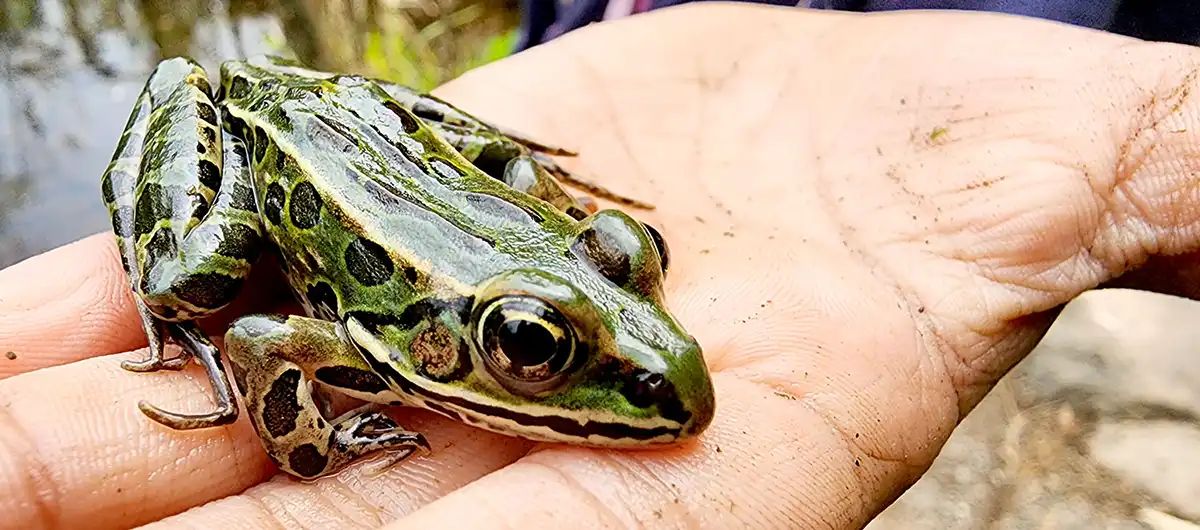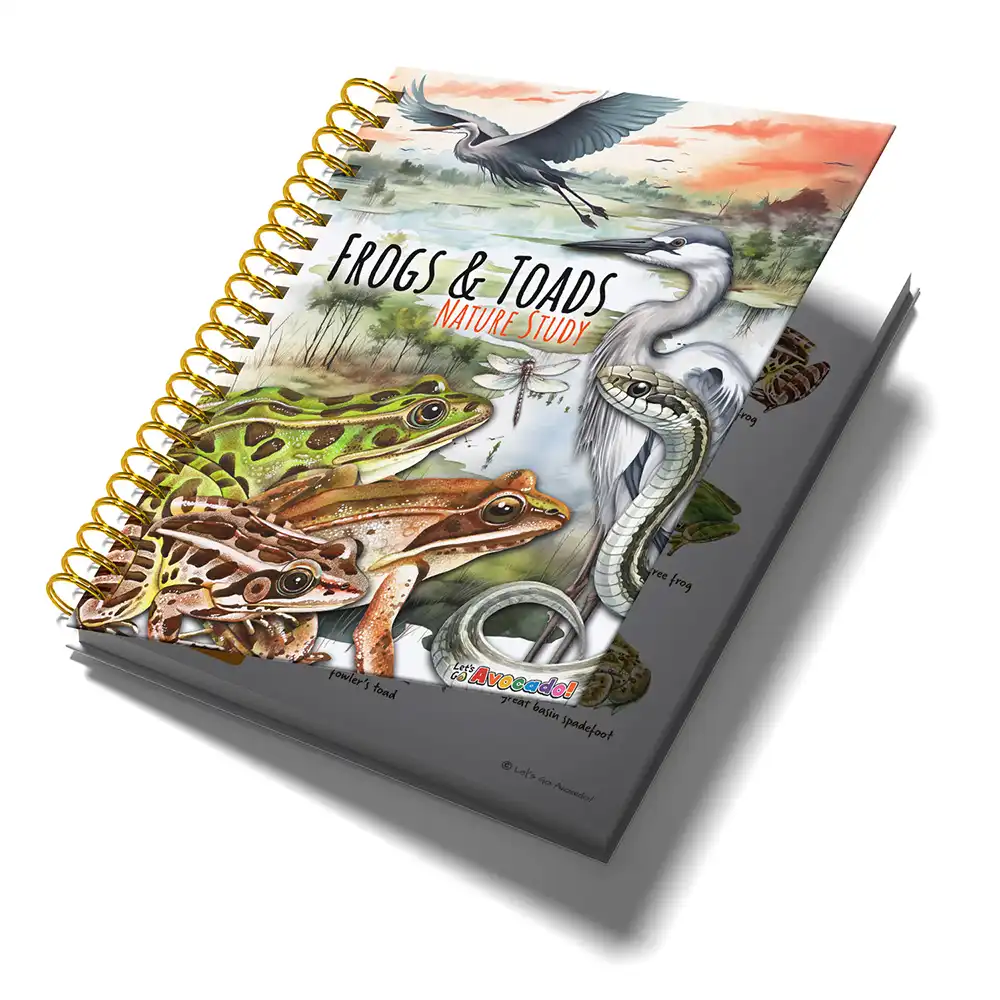This page may contain affiliate links.
Read our disclosure and privacy policy here.
The lifecycle of frogs and toads is a fascinating process that really showcases the wonders of nature. It all begins when adult frogs or toads lay their eggs in water. These eggs eventually hatch into tiny, aquatic creatures called tadpoles. Tadpoles have gills and swim using their tails, just like fish. But as they grow, something extraordinary happens: they undergo a remarkable transformation known as metamorphosis. During this stage, their bodies change dramatically. They develop lungs for breathing air, their tails shrink, and their legs start to form. They’re turning from water-dwelling tadpoles into land-dwelling frogs or toads! Once they complete their metamorphosis, they leave the water and explore their new terrestrial habitat. Frogs and toads play an important role in the ecosystem by controlling insect populations and serving as a food source for other animals. Let’s take a closer look at each of the steps in the lifecycle of frogs and toads.
Table of Contents
The Amazing Lifecycle Of Frogs and Toads
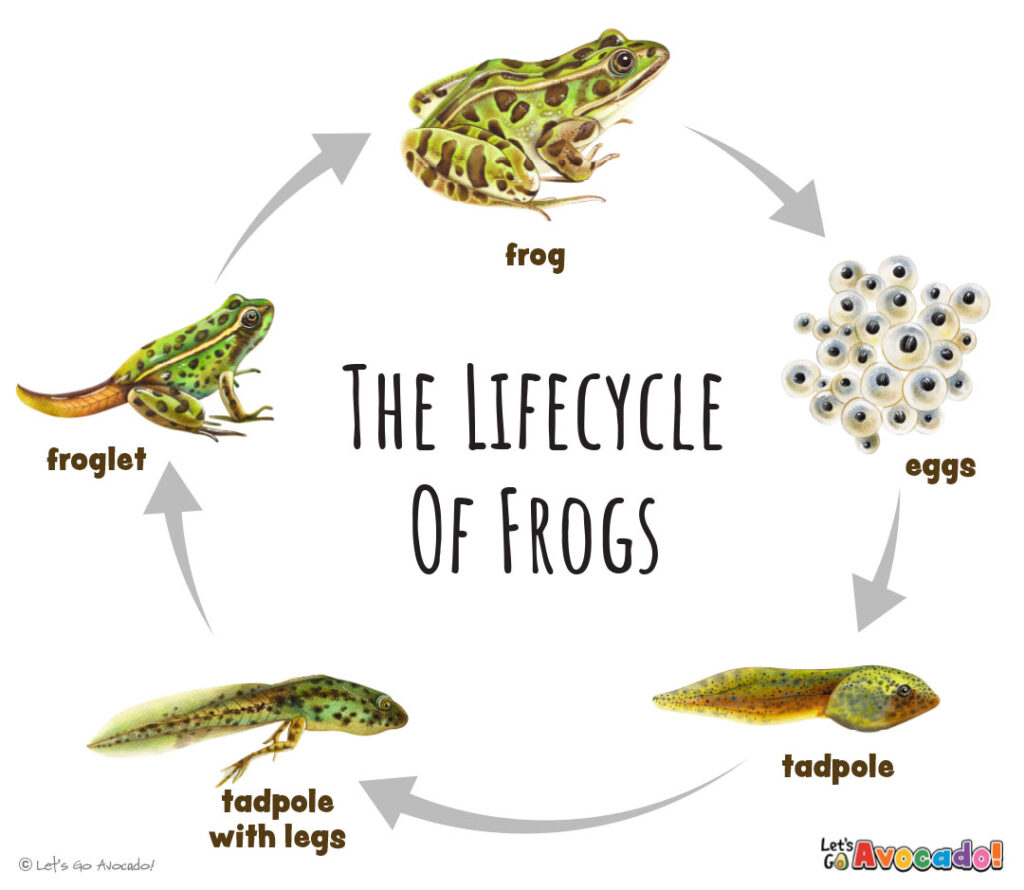
Stage 1: Eggs
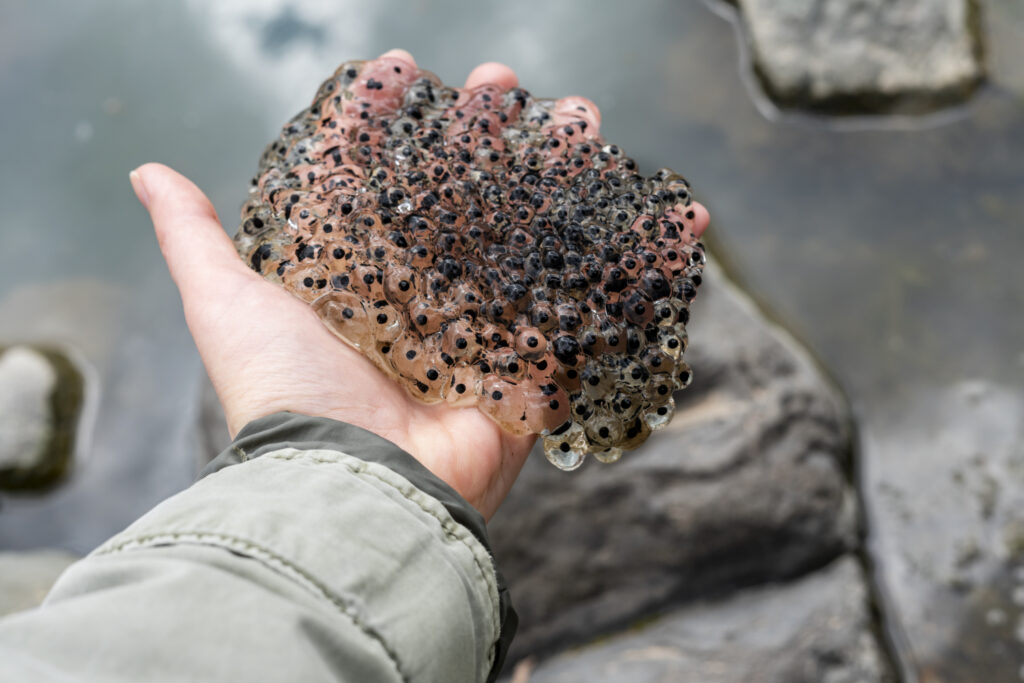
The first stage of the frog lifecycle is the egg stage.
The first stage of the frog and toad lifecycle is the egg stage. This is where the journey of life begins for these amazing amphibians. Adult frogs or toads lay their eggs in water, typically in ponds, lakes, or wetlands. The eggs are usually laid in large clusters or masses, and they are covered with a jelly-like substance that protects them from harm. Inside each egg, a tiny embryo starts developing. The eggs remain in the water until they hatch into tadpoles. If you’re interested in exploring this stage in more detail, check out this article about frog and toad eggs.
Stage 2: Tadpoles
The second stage of the frog lifecycle is the tadpole stage. After hatching from the eggs, the tiny tadpoles emerge and live in the water. Tadpoles look very different from adult frogs. They have long tails, no legs, and gills for breathing underwater. Tadpoles spend most of their time eating and growing. They have a specialized mouth called a “mouthpart” that helps them scrape algae and other plant matter for food. As they grow, they go through a process called metamorphosis. This is when their bodies start to change. They develop hind legs first, followed by front legs, and their tail gradually shrinks. At this stage, they also start developing lungs, which allow them to breathe air. Eventually, the tadpole fully transforms into a frog. It’s an incredible transformation!
You can learn a few more cool facts about tadpoles in this article.

This cute little tadpole is the second stage of the frog lifecycle.
Stage 3: Metamorphosis
The third stage of frog and toad development is a fascinating transformation called metamorphosis. During this stage, both frogs and toads undergo significant changes as they transition from aquatic tadpoles to terrestrial adults.
For frogs, this stage begins when the tadpole starts to develop hind legs. The hind legs grow first and allow the tadpole to swim more effectively. As the hind legs continue to grow, the front legs begin to appear. Eventually, the tail starts to shrink, and the tadpole develops lungs for breathing air. It starts to spend more time near the water’s surface, using its developed legs to propel itself and explore the land. Over time, the tail disappears completely, and the tadpole transforms into a fully formed frog.
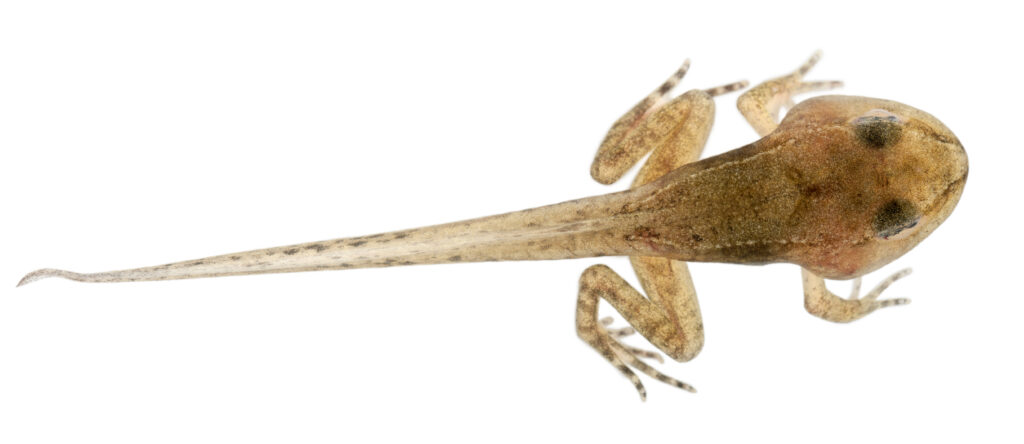
In the metamorphosis stage, the tadpole grows legs and arms, and gradually loses its tail.
Similarly, for toads, the third stage involves the development of hind legs and then front legs. As the legs grow, the tail gradually diminishes, and the toad tadpole adapts to life on land. The toad tadpole’s body shape changes, becoming more robust and less streamlined compared to its aquatic stage. Eventually, the tail is absorbed, and the toad completes its metamorphosis into an adult toad.
It’s important to note that the exact timing and duration of this stage can vary between frog and toad species. Some species may complete metamorphosis relatively quickly, while others may take several weeks or even months.
The third stage of development is a remarkable and critical phase in the life of frogs and toads. It allows them to transition from their aquatic habitat to a life on land, where they will continue to grow and mature into adult frogs or toads. Check out these facts about frog metamorphosis you might not know aobut.
Stage 4: Young Adult
Once the metamorphosis is complete, the young frogs and toads leave the water and venture onto land. They have fully developed legs and lungs, allowing them to explore a new world. At this stage, they are still small and may look different from the adult frogs and toads. Did you know that some young frogs and toads have bright colors that act as a warning to predators? It’s their way of saying, “Don’t eat me, I’m toxic!” Young frogs face a number of new challenges now that they are partly terrestrial. Read this to learn more about the incredible challenges faced by froglets and toadlets.
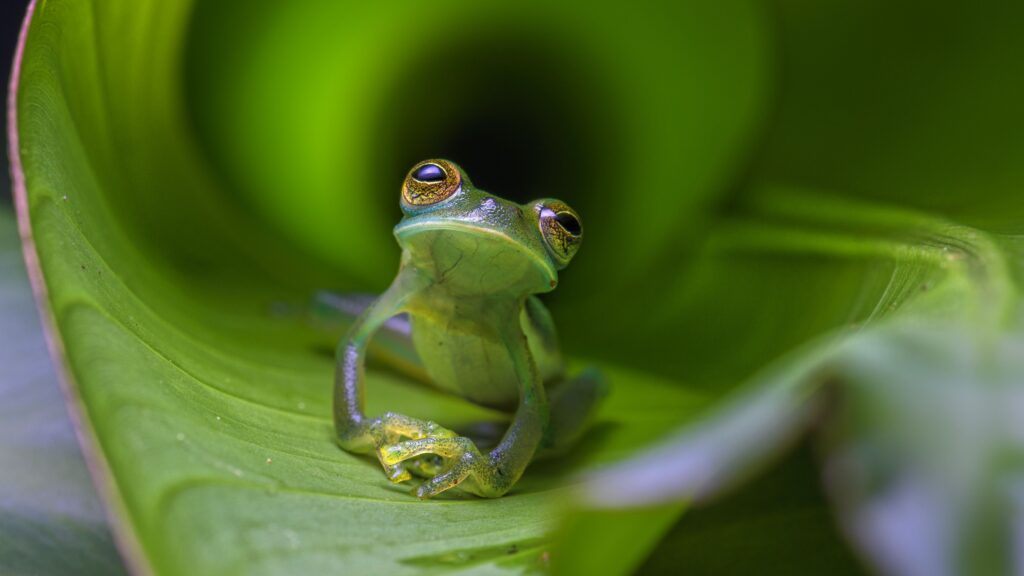
In the metamorphosis stage, the tadpole grows legs and arms, and gradually loses its tail.
Stage 5: Adult Frogs and Toads
As the young frogs and toads continue to grow, they eventually reach adulthood. They now have their distinct adult form, with all the features that make each species unique. Adult frogs and toads have powerful hind legs for hopping and catching prey. They also have specialized skin that helps them breathe and stay moist. Did you know that some frogs and toads can jump up to 20 times their own body length? That’s like a human jumping over a school bus!
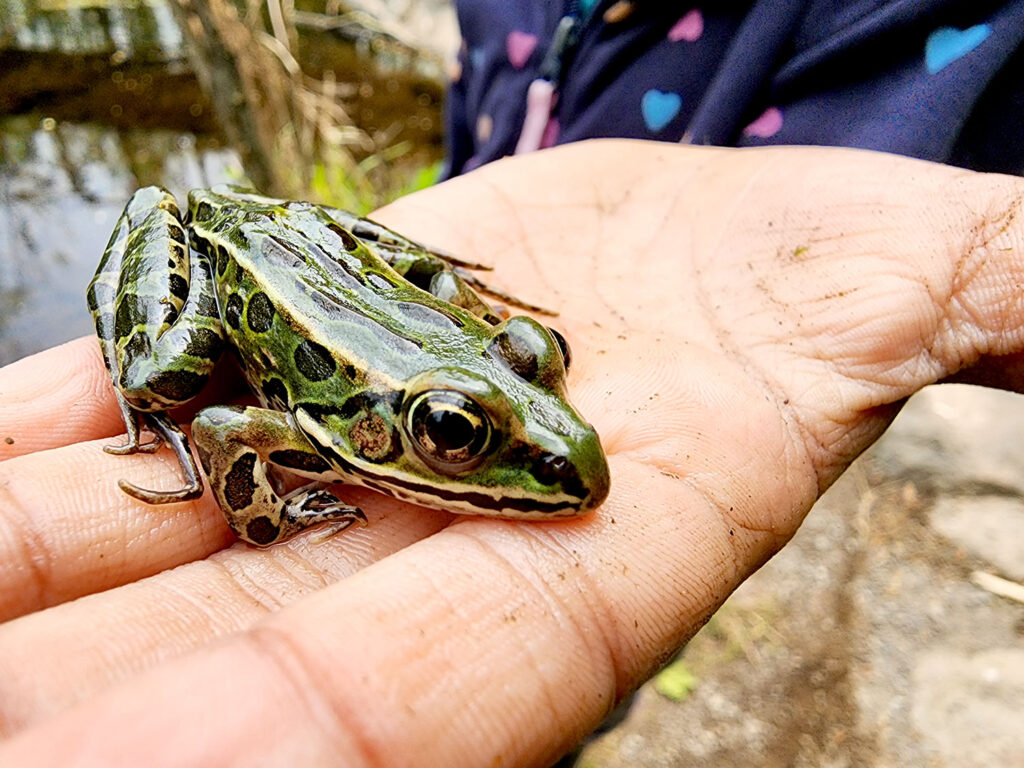
Adult frogs were strong enough and resourceful enough to survive a lot of challenges. Now their next challenge is to find a mate to reproduce and crate the next generation of tadpoles!
Stage 6: Breeding
Once adult frogs and toads reach sexual maturity, they are ready to breed and continue the cycle of life. During the breeding season, males call out to attract females. Their calls can vary greatly among species, from high-pitched chirping to deep croaking. You can check out some frog calls in our Frog ID section.
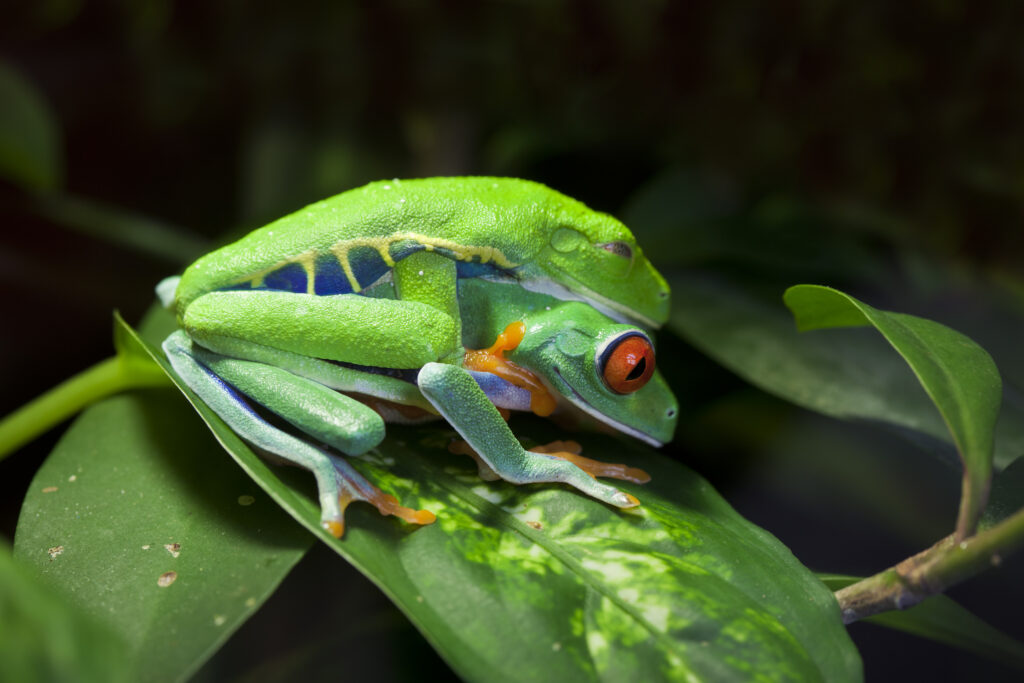
Frogs breed in a process called amplexus. The male frog fertilizes the eggs as the female lays them. This process can last hours or even days!
Stage 7: Parenting
After successful mating, female frogs and toads lay their eggs, completing the lifecycle. But here’s an interesting fact: not all frogs and toads abandon their eggs after laying them. Some species, like the male Darwin’s frog, carry the eggs in their vocal sacs until they hatch!
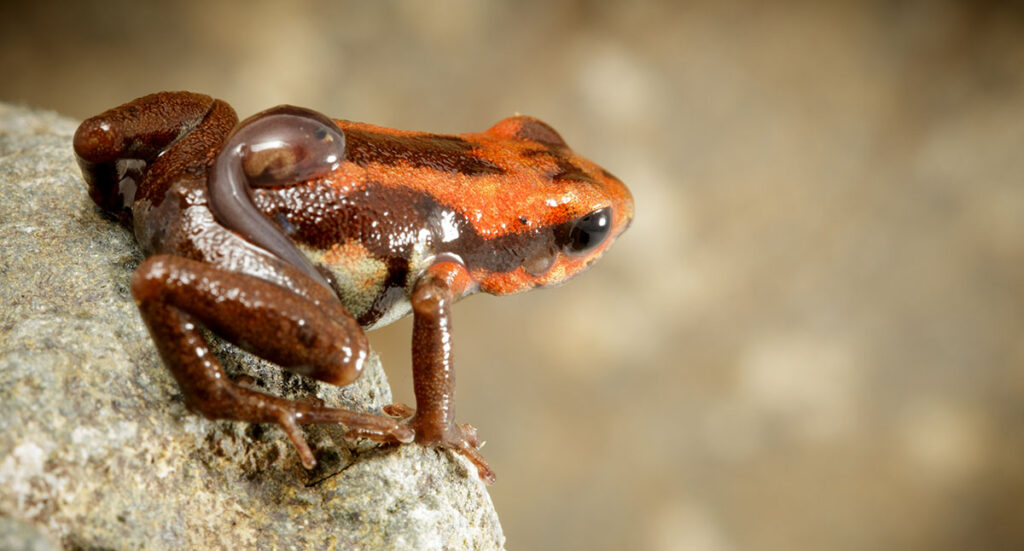
Frogs and toads have many different ways of parenting. Some will not care for the eggs at all after they are laid. Some others go to the extreme of carrying their young in their mouth until they are ready to go out on their own! The poison dart frog (Andonobates bombetes) pictured above will carry newly hatched tadpoles on its back until it find a suitable pond where it can drop them off.
Fun Facts About the Frog and Toad Lifecycle
- Egg to Tadpole: Frogs and toads start their lives in a very different form. After the female lays eggs, these eggs hatch into tadpoles. Tadpoles look more like fish than frogs or toads because they have tails and live entirely in water. This stage shows how adaptable these creatures are, starting life in water before moving to land.
- Growing Up: Tadpoles don’t stay little for long. Over time, they undergo changes, a process known as metamorphosis. They grow legs, their tails get shorter, and their gills (which they use to breathe underwater) change into lungs for breathing air. This transformation is fascinating because it shows how an organism can completely change its body to adapt to a different environment.
- The Tail Disappears: As tadpoles transform into adult frogs or toads, their tails aren’t just lost; they are absorbed by the body. This means the energy and material from the tail are reused to support the growth of the rest of its body. It’s a great example of how nature doesn’t waste resources.
- Jumping Abilities: Once they are fully grown, frogs and toads have powerful legs that allow them to jump several times their body length. This skill is crucial for escaping predators and moving quickly from one place to another. It’s an impressive feat of strength and agility for such small creatures.
- Survival Techniques: Frogs and toads have unique ways to survive different climates. Some species can survive freezing temperatures by partially freezing themselves and then thawing out with no harm done. Their bodies produce a substance that prevents ice from forming inside their vital organs, allowing them to “come back to life” in the spring.
FAQ: Amazing Frog and Toad Lifecycle Facts
Do all frogs and toads start as eggs? Yes, all frogs and toads begin their life cycle as eggs. The eggs are laid in water and hatch into tadpoles, which is the first stage of their life.
What’s the difference between a frog tadpole and a toad tadpole? Frog tadpoles are often found in cleaner, clearer waters and may have longer tails and sleeker bodies. Toad tadpoles can live in a variety of water qualities, including murky ponds, and they’re often darker in color. However, both go through similar stages of growth.
How do tadpoles breathe underwater? Tadpoles breathe underwater through gills, just like fish. As they grow and start to transform into frogs or toads, they develop lungs to breathe air.
Why do tadpoles turn into frogs or toads? Tadpoles turn into frogs or toads through a process called metamorphosis. This change allows them to live on land and not just in water, adapting to their environment as they grow.
How long does it take for a tadpole to become a frog or toad? The time it takes for a tadpole to fully transform can vary from species to species, ranging from a few weeks to several months. The entire process depends on factors like temperature and the availability of food.
Do frogs and toads eat the same things as tadpoles and adults? No, their diets change. Tadpoles mostly eat algae and plant matter, while adult frogs and toads typically eat insects, worms, and sometimes small fish. This change in diet is part of their growth and development.
Can all frogs and toads jump? Most frogs and toads have powerful legs for jumping, which is a key feature of their mobility. However, the distance and height they can jump vary widely among species. Some are better at hopping or walking than making long jumps.
Do frogs and toads have predators? Yes, frogs and toads have many predators at different stages of their life cycle. Eggs and tadpoles are eaten by fish, insects, and even other amphibians, while adult frogs and toads can be preyed upon by birds, snakes, and mammals.
How do frogs and toads survive winter? Some species of frogs and toads hibernate during the winter in mud at the bottom of ponds or in leaf litter on the forest floor. Certain frogs can even survive being frozen by producing a kind of “antifreeze” in their bodies that prevents ice from damaging their vital organs.
Can frogs and toads hear? Yes, frogs and toads have an excellent sense of hearing. They have eardrums, called tympanums, on the sides of their heads that allow them to hear both airborne and waterborne sounds. This is important for communication, especially during mating season when males call to attract females.

There’s a lot to explore right where we are, in our own neighborhoods and backyards! Join us while we get off the couch and explore the everyday wonders of nature, science, space, engineering, art, and anything else we stumble upon during on our adventures.


